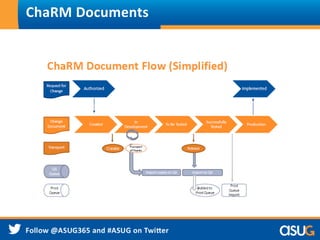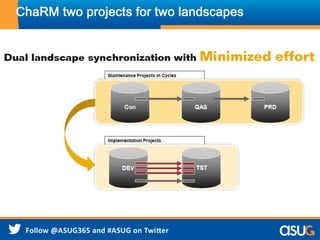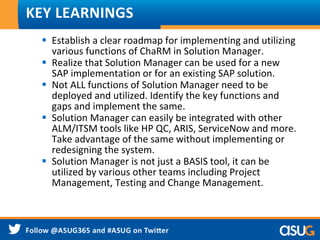Ad
Using SolMan ChaRM, CSOL and Retrofit to support a dual project and production environment
- 1. ITM 116 ITM116 Using ChaRM, CSOL, and Retrofit to Support a Dual Project and Production Lovnish Mahajan –SAP BASIS and Solution manager Architect Robert Max- Application Technology Manager, Novelis
- 2. LEARNING POINTS Describe how Change and Request Management (ChaRM) from Solution Manager supports the development and configuration process Lists the Important steps to deploy ChaRM in your organization Describe how ChaRM functionality of CSOL and Retrofit supports a dual production support and project landscapes
- 3. PROJECT BACKGROUND Novelis has launched a global deployment of SAP solution across various regions and locations. Standard ALM tools and ASAP methodology has been established for the implementation of the solution. Implemented the change management process and transport management for the dual landscape systems at Novelis. Solution Manager tool was also setup to be for implementation functions including global templates, business blueprinting, documentation and test management.
- 4. About – Lovnish Mahajan Partner in Parvotech Inc.- SAP consulting boutique - specializing in remote BASIS, Solution Manager and HANA consulting . SAP Certified BASIS, HANA and Solution Manager Architect. Over 15 years of experience in SAP BASIS Technologies, ALM, ITSM and Security with SMBs and Fortune 500 companies. Extensive Experience in strategy, design, development and successful deployment of Application Life Cycle Mgmt. and IT service Mgmt. Speaker at various conferences including SAPPHIRE, ASUG Annual conference and SAP TechEd.
- 5. About – Robert Max Is currently responsible for the technical support of Novelis’ portfolio of global applications including the teams supporting Solution Manager and delivering SAP Basis and Security Administration services. He has had a key role in the construction of two of the world’s largest SAP Implementations for Fortune 500 consumer products companies. Active in ASUG, Robert was the founding leader of the Solution Manager SIG, has spoken at numerous ASUG Annual Conference, SAP Active Global Support and TechEd Conferences as well as many regional events. He has presented at ASUG events, TechEd and SAPPHIRE and awarded best presenter at an SAP AGS event in Walldorf
- 6. Novelis Global Footprint 9 1,800 Countries 25 2,786 Kt Employees Revenues North America 3,100 $3.4 Billion Europe $3.2 Billion 1,800 Employees Shipments Operations $9.8b Revenues 11,000 FRP Shipments 988 kt and Sales Based on FY 2013 Results; Employees as of March 31, 2013 4,300 847 kt Asia $1.8 Billion 556 kt South America $1.4 Billion 395 kt Shipments and Sales Based on FY 2013 Results; Employees as of March 31, 2013
- 7. Introduction to Novelis and SAP Program Novelis is the world leader in rolled aluminum products, delivering unique solutions for the most demanding global applications, such as beverage cans, automobiles, architecture and consumer electronics. First SAP Go-Live 2012 2014 Where Used U.S and Canada, Worldwide SAP Version Installed Other Bolt-ons, Applications Implemented ERP- Ehp5, BI 7.3, SCM 7.0 Ehp2, SBOP 4.0, GRC, Solution manager-SP11 SABRIX, TIBCO, SharePoint, SaaS applications i.e. Poornata, Rate hub, Legacy MES interfaces Adopted SAP Application Life-Cycle Management ChaRM, SD, SMSY, Monitoring, HP ALM Team dynamics Novelis CoE ( Center of Excellence) AMS and SAPoD Hosting partner
- 8. Novelis – Use of Solution Manager Road Map Service Desk ChaRM – Change Request Management Business Process Change Analysis Integration to HP QC Integration to Job Scheduling System Business Process Management Incident and problem Management Multilevel Categorizatio n Service Level Agreement (SLA) Monitoring Implement ChaRM( Normal, Urgent, Defect) Automated workflow and approval process Automation for transports of the production environment Retrofit and CSOL Management Dashboards and reporting Integrate HP ALM with Solution Manager Best practices for Testing Automated testing – Integration testing Integration into SAP TAO Integrate external job scheduling system into Solution Manager Best practices for Batch job Process Automated Incident and Change Management Activate Business process Monitoring Activate Business process Management SLA setup Management Scorecard/ reporting Use BPCA for support pack upgrade, Major release upgrades Include BPCA in change request management
- 9. Agenda How Change and Request Management (ChaRM) from Solution Manager supports the development and configuration process Deploying ChaRM in your organization How ChaRM functionality supports a dual production support and project landscapes
- 10. Change Request Management (ChaRM) Enables the management of SAP Solution Manager projects from top to bottom: Starting with change management and project planning, through resource management, to physical transports of changes from the development environment into the productive environment. Scope Distribute software changes of ABAP and non-ABAP objects (CTS+) Comprehensive, workflow-driven management Management of maintenance, template, implementation, and upgrade projects Benefits Increased maintenance and project efficiency Reduced risk of correction and project failure Minimized costs for project management & IT
- 11. ChaRM:Pain Points ChaRM automates previously manual procedures: Spreadsheets of changes and transports Closely couple documentation with the change Synchronize change status with TMS status ChaRM addresses questions like Who requested change X? Who tested change Y? What changes are still in development? Being tested? Waiting for production ? ChaRM vs TMS TMS automates the transport process and ChaRM automates the paperwork: Approvals, Maintenance Cycles, Document reasons, related docs and Integrates with TMS
- 12. ChaRM:Pain Points Who Uses ChaRM ? Typical roles: Change Manager :Tracks changes, expedites the processes, controls the maintenance cycle Lead/Solution Architect: Create a Change Document (CD) for the requested and confirmed (e.g. CCB) change. Developer/Configurator: Makes transportable changes and releases to tester Tester: Tests in QA and confirms successful test Basis: Automates QA imports, Manually performs production imports
- 13. Change Request Management ChaRM
- 14. ChaRM Documents
- 15. 15 ChaRM and TOCs ■ ChaRM Uses Transport of Copies to avoid releasing the original transport until unit testing is complete and Reduce the number of transports into production completed
- 16. Lead: Configuration I – Create Change Document (CD) Ensures that all mandatory fields (especially the project and the Change Manager) are filled in the right form. 16
- 17. 17 Lead: Configuration II
- 18. 18 Lead: Configuration III Scroll down until you reach the Transport Management area and create a transport Additional Transports or Tasks could be added later if it would be necessary due to changes of Business Processes or Functions or Resources within the team. There will be an one to one between Tasks and Developer/Config people.
- 19. 19 Lead: Configuration IV The result is shown in the Change Document – Task list appears by clicking on the loupe. The transport(s) could be imported later into Q1E/Q2E once the configuration will be done and the tasks in the DEV system will be released (Email from the processor).
- 20. Processor: Configuration I ■ Select the Object you are configuring. Click the Configure button, you will be routed to SPRO in D1E:100 client 20
- 21. Processor: Configuration II ■ Complete the configuration in D1E:100 and save 21
- 22. Processor: Configuration III Click on Own Requests instead of New Requests. Choose the one given by the Lead 22
- 23. Processor: Configuration IV Do the Unit Test in D1E 300 once configuration (DGE 100) will have been done (transport could be copied with SCC1). DGE 100 /nSE10 Only the task and not the transport has to be released Send a mail to your lead to inform him or her that your part of the transport (task) is ready for the integration test in Q1E 300 23
- 24. Lead: N+1 Configuration I Checking the CD to see which of the tasks assigned to the specific transport are already released. In this case not all tasks are already released. So the lead has to wait for ‘Robert Max’ or to ask him to release his task also Click on the following action once all tasks will be released. 24
- 25. N+1 Tester: Test the ‘Normal Change’ Scroll down up to the Landscape area and jump into the QGE 300. Do your tests following the test instructions. 25 Add a test report Inform the Processor concerning the test result through email Click on the following action if the test result was bad. Only the Change Manager is allowed to ‘Confirm Successfully Test’.
- 26. Agenda How Change and Request Management (ChaRM) from Solution Manager supports the development and configuration process Deploying ChaRM in your organization How ChaRM functionality supports a dual production support and project landscapes
- 27. ChaRM Challenges Imposes discipline on the change management process: Resistance to Normal changes (“But I want my change now!”) Transports must be managed as part of ChaRM (“But I want to create my own transport directly in SE09!”) Each change must be assigned to a project, categorized as Normal or Urgent, etc.: requires training Support for ChaRM is cross-disciplinary Consider managed services for ChaRM instead of dumping it on BASIS
- 28. Project Team Trainings (not exhaustive) NPL Novelis Project Lifecycle Training Code Short Code Training Details Audience NPL101 Tools Overview Tools Overview for Novelis 2.0 (Solution Manager, HP ALM, Share Point, SAP Productivity Pak) All Novelis2.0 Team members Project Administration This training is related to Projects and Project Admin. · Create Projects (Template, Implementation, Maintenance, Upgrade) · Project Administration - Create Project · Project Administration - Compare and Adjust Administration This training is related to Administration of the BPH and creating/modifying the BPML · Creating/Modifying the Business Process Hierarchy · Creating/Modifying the Business Process Master List Administration This training is related to Administration and Management of the WRICEF Project · Administer the WRICEF Project · Production Support Changes to WRICEF Objects · Using WRICEF Objects in multiple Projects · Compare and Adjust WRICEF Objects to relevant projects This training is related to Transport Management for Project Landscape. · Creating a Change Request · Assigning Transports to Team · Prepare List of Transports for Batch move · Transport Approval Process · Verify Transport Move Release Management Release Management for Production Support & Project Implementations NPL100 + NPL180 NPL110 + NPL180 Configuration This training is on Application Configuration in Novelis Configuration Experts, Functional Leads, Consultants, Integration Managers NPL120 + NPL180 Development This training is on Application Development in Novelis Development Experts, Technical Leads, Consultants (ABAP, TIBCO) Testing from SolMan This training is related to Testing in Solution Manager · Functional Unit Testing · Technical Testing of Development Objects · Develop Test Cases · HP ALM Project Sync (Transfer Requirements) Configuration Experts, Functional Leads, Technical Leads, Consultants (Functional & Technical), Developers, , Integration Managers, Test Lead, Testers Testing This training is related to Testing (QA COE) · Build Test Cases for Regression in HP ALM · Build Test Cases for Automation · Build/Load Test Cases for Manual Testing in HP ALM · Build/Finalize Test Labs (All Test Cycles) Integration Testing Integration Testing Defect Management Defect Management NPL510 TIBCO Administration This training is related to Administration and Management of the TIBCO Project · Administer the TIBCO Project · Production Support Changes to TIBCO Interfaces Objects · Using TIBCO Interface Objects in multiple Projects · Compare and Adjust TIBCO Interface Objects to relevant projects Development Lead, Integration Manager, TIBCO Lead NPL180 Change Management Scope Change Management All Novelis2.0 Team members NPL170 Training Build This training is on End User Training Build (Simulations recording in Solution Manager) · Develop Business Process Procedures (Training Material) Business Analysts, Functional Experts NPL150 Project Managers, Administrators, Integration Managers, Development Leads, Functional Leads, Technical Leads,
- 30. Agenda How Change and Request Management (ChaRM) from Solution Manager supports the development and configuration process Deploying ChaRM in your organization How ChaRM functionality supports a dual production support and project landscapes
- 31. ChaRM two projects for two landscapes
- 32. Cross System Object Lock The cross-system object lock ensures that when an object is changed in a satellite system, a lock entry is created for this object in the central SAP Solution Manager system. Depending on the selected conflict analysis scenario, this lock entry prevents changes being made to this object in any other transport request. This applies to all satellite systems and clients for which the cross-system lock has been activated. 32
- 33. 33 CSOL Example Config lead C2C creates a new transport within the C2C functional CD for DGE 100 (Maintenance Dev system) to fix a bug in the customization table ‘Payment Terms’ and send the transport number to the configurator BRUCHM Configurator BALLUSUS wants to configure ‘Payment Terms’ out of SOLAR02 within the R2 project for D1E 100 ( Project Dev system) using an existing C2C transport.
- 34. 34 CSOL Example Configurator BALLUSUS gets the following error message and has to cancel this change or to store it with a different key. In all cases he should contact BRUCHM to discuss and solve this conflict. This lock exists until BRUCHM released his transport and until his transport will be imported into production.
- 35. Cross System Object Lock DGEK901234 Object V_T187 Key XYZ D1EK905678 CSOL Table PGY 300 35 Object V_T187 Key XYZ Future and normal situation 1st 2nd
- 36. Additional control functions in ChaRM => CSOL Change Document in PGY
- 37. 37 Retrofit The main new features and advantages of the Enhanced Retrofit Functionality can be summarized to: Automatic Categorization of Objects (Auto Import, Semi-automatic, and Manual) Automatic Categorization of Objects (Auto Import, Semi-automatic, and Manual) The categorization takes place after the release of a transport request. The release creates the retrofit data.
- 38. ChaRM - Retrofit to keep both landscapes in snyc
- 39. ChaRM - Retrofit to keep both landscapes in snyc
- 40. Retrofit to keep both landscapes in snyc III
- 41. Lead: Usage of Retrofit 41 . showing the key(s) or objects which cause the conflict. You could add notes You could compare the object in DGE with D1E You could confirm the object once the conflict is solved or it becomes clear that the target should be overwritten.
- 42. Lead: Usage of Retrofit – Dependency The button showing you the Sequence Dependencies. With you switch into the Correction Workbench. 42 .
- 43. Lead: Start Retrofit from a CD You could start the retrofit process from the CD once you got a Email from the Change Manager that there is a conflict. CD needs to be in the following status: 43 Jump into PGY 300 The list showing all transport requests which belong to the CD. Double click on a line to get the details of the transport request including conflicts on the object level.
- 44. Typical ChaRM Implementation Timeframe
- 45. RETURN ON INVESTMENT Avoid the manual process of synchronizing changes between Project and Support SAP systems. Reduce the schedule and timeline for managing changes between multiple systems but automating the process. Extending other Solution Manager functions including Solution documentation, end to end testing – provides a comprehensive Change Mgmt., solution with out the need of 3rd party tools.
- 46. KEY LEARNINGS Establish a clear roadmap for implementing and utilizing various functions of ChaRM in Solution Manager. Realize that Solution Manager can be used for a new SAP implementation or for an existing SAP solution. Not ALL functions of Solution Manager need to be deployed and utilized. Identify the key functions and gaps and implement the same. Solution Manager can easily be integrated with other ALM/ITSM tools like HP QC, ARIS, ServiceNow and more. Take advantage of the same without implementing or redesigning the system. Solution Manager is not just a BASIS tool, it can be utilized by various other teams including Project Management, Testing and Change Management.
- 47. THANK YOU THANK YOU FOR PARTICIPATING Feedback Please complete a session evaluation for this session!



















































































































